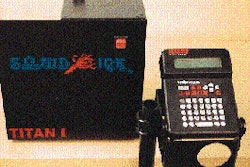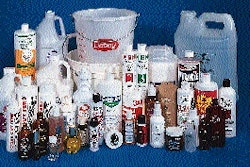New product development at food, drug and other packaged goods manufacturers is conducted behind a veil of secrecy for obvious reasons. After all, why tip your hand to the competition any sooner than you have to? But is there a downside to this guarded approach? Wouldn't prospective vendors be much better positioned to supply more appropriate, quicker solutions if they had more access to their customers' research and development people instead of having to put up with this atmosphere of secrecy, which some describe as the "arm-in-the-white-lab-coat syndrome"? Clemson University's Bob Testin, who chairs South Carolina University's school of packaging, believes the answer is yes. The way he sees it, how can a vendor know why his proposed solution missed the mark when the vendor is stuck outside the development process and sees nothing more than that anonymous white-coated arm taking in ideas and handing back rejections? Testin encourages packaging R&D people of today and tomorrow to find ways of developing a more collaborative approach to their business. Based on comments ascertained from several packaging experts, collaboration makes perfect sense. For example, packaged goods manufacturers appear to be relying more and more on their vendors for material and machinery suggestions. One likely reason for this is simply that manufacturers are not teeming with R&D personnel. Economics most certainly factor into this equation. Those firms with deeper pockets may have engineers that work for an R&D manager who in turn reports to a Director of Packaging, or a person with a similar title. "In many consumer-oriented companies like ours, packaging development is being whittled back and outsourced," explains Jim Scott, director of packaging development for Nabisco Biscuit Co., East Hanover, NJ. "Some companies rely ultimately on suppliers," he continues. "We've kept a strong packaging development group, but designing packaging is really not our business. We take world-class technology from our material or equipment suppliers to help us move a product to market. We need to integrate their ideas to develop a cost-effective, user-friendly product and package quickly, rather than having to invent something." John Lowery, an executive affiliated with recruitment firm Quality Search, concurs, but with an added recommendation. "Packaging research and development has to really push the vendor in terms of thinking outside the box. You have to come across as creative, thinking outside the limits of today's technologies for ideas on different ways to get the job done." Global perspective The successful R&D manager of the future will need to look far beyond the expertise of his supplier(s). While the expression sounds trite, the "global marketplace" is already a reality. Yet how many R&D pros actually peer out beyond the four walls of their corporate fortress to understand what this really means to the firms that employ them? "If you're going to work for a large company, chances are that at some point, that company will go international. When it does, you'd better have a damn good perspective outside your own little world," argues Norm Nieder, group director, Packaging Technology Group, Anheuser-Busch. "If you've only been exposed to the neat, nice, perfect world of suppliers in the U.S., you'll be in big trouble once you start to do business in the second or third world," he says. Can you train for such an experience? "The broader the exposure you have, and the more oddball the experiences, the more unconventional ways you have to [accomplish] things." He points out that lessons can be learned from companies like McDonald's and Coca-Cola that have done well around the globe. "Their objective is to understand the local culture. What's good in America isn't necessarily good for everyone else. So you'd better learn what makes them tick and then work within that particular system," Nieder says. As Nieder suggests (see sidebar on p. 93), setting up shop around the globe can have its perils. "In the last four years, we've spent considerable time learning about the global marketplace. One of the things we've been able to do to source materials is to rely more heavily on multinational companies that have tentacles outside of the U.S.," he explains. The same goes for packaging equipment, though Nieder warns that using machinery to replace manual labor can be a tricky business, particularly in the Far East. For example, he says, "We have a brewery in China that employs about five times the number of people used in our stateside plants. But when we bought an 80 percent stake in the brewery, we also bought 100 percent of the workers. And for many of these jobs, it's 'till death do you part.'" The importance of the "people side" of an international packaging operation cannot be overstated. "You have to practice a lot of restraint, otherwise you can easily overwhelm these people," Nieder believes. "You have to think about how far you can take these people without demoralizing them." Chris DeCoster, a senior packaging engineer for the R&D Food Division within The Dial Corp, agrees with Nieder that the Asian market represents a huge opportunity for packaging companies. To take advantage of opportunities regardless of geographic location, he recommends "any type of international work experience. It is becoming more important whether it's in distribution, working with international copackers, developing foreign language skills or understanding different customs. The real opportunities are in developing countries." He believes these skills take on added significance considering what he perceives as limited opportunities in the U.S. "The markets here are saturated. Everyone is stealing market share from everyone else," he says. Business acumen Some of our experts believe that business-oriented concepts like share of market ought to be at the forefront of the R&D manager's thought process. "More than ever, R&D will have to resist the temptation to be enamored of pure technology and focus on business needs," believes Mark Niemiec, vice president and director of packaging at Campbell Soup, Camden, NJ. Bob Patel, plant engineer for United Distillers Production in Plainfield, IL, says "There's a need for more of a business background in making buy or sell decisions. You need to at least understand the break-even point. The business and economic aspects, and an understanding of their own business, is something I don't always see in people." Bruce Cohen, Glaxo Wellcome's director of packaging, gives an example related directly to the pharmaceutical/medical market his company serves. "R&D people won't be able to work in as much of a vacuum as they used to. They'll have to become part of the business team to a greater extent. Decisions need to be made as business decisions, not strictly R&D decisions, so R&D will have to ask themselves 'what's the impact on the business down the road?'" In a broader sense, he says, "most of the science and effort has been in the discovery of new medicines, with packaging viewed as a necessary evil. It's as if companies were saying, 'We have to put this product in something, so you guys figure this out.' In the future, "there will have to be more interaction between product development people and packaging R&D." Especially for pharmaceutical companies, Cohen believes. "The ideal packaging R&D person will have not only the knowledge of the packaging materials but also understand the interaction of those materials with the product being marketed," he says. World Wide Web Without exception, our experts called on R&D personnel to arm themselves with as much information and computer-related training as possible. "The R&D professional will have to be a wizard at information technology," asserts Aaron Brody, managing director, Rubbright Brody. "Not only for day-to-day problems related to manufacturing and marketing, but in knowing what happened at the latest interpack show one nanosecond after it closed. We're drowning in information." Speaking of information, the World Wide Web represents another tool for R&D. "Via the Web, we were able to locate a legal consultant in Hong Kong to obtain an e-mail translation of local box coding requirements, free of charge," explains Paul G. Russell, corporate packaging program manager for Hewlett-Packard, Palo Alto, CA. "Within a day, we were able to analyze the law and respond appropriately. "In the future," he says, "it would be really beneficial to use this technology to be able to get design information from suppliers." Not surprisingly, computer-aided design and computer-aided manufacturing was seen as a skill growing in importance, according to our experts. Dial's DeCoster says packaging drawings and specifications must be accessible on a database to people at the plant level, instead of relying on paper manuals that may be outdated. Dr. Jorge Marcondes, the packaging program director at San Jose State (CA) University, emphasizes software as a tool that can assist packaging operations ranging from the design of folding cartons and corrugated cases to programs that specialize in case and pallet stacking patterns. Additional skills Knowledge of plastics, testing procedures, science and math topped the list of basic skills needed by future packaging R&D pros. "Understanding resins and material processes is extremely important," says John Lowery of Quality Search. "That's very helpful if you want to get into the consumer products, HBA or cosmetics business." He also says that, "companies are becoming more flexible in the hiring process. They will create a job, or tweak an existing job to fit a set of skills a person brings, if that person comes across as technically sharp." Dan Goodwin, chairman of the department of packaging at Rochester Institute of Technology, Rochester, NY, elaborates on the importance of knowing materials. "The R&D person will have to know how to optimize material usage, understand what happens when plastics are burned in a municipal incinerator, and what happens when you try to grind up coextruded material for remelt and reuse." Testing skills, often learned at packaging schools, should benefit future R&D professionals. "With all the new packaging materials coming onstream, shock and vibration testing will gain in importance," says Nicolle Dutts, packaging engineer/ senior associate for IBM's Custom Solutions Manufacturing/Technical Services Laboratory. "On many of these newer materials, there is a limited amount of information or product history," she says. "If a person's testing skills aren't solid, you won't have a good understanding of shock, g-levels and cushion curves. It will be like guessing. You have to be able to understand what a product will incur during the distribution cycle and design a package that will stand up to that cycle." San Jose State's Marcondes believes that companies will need to scrutinize testing techniques as they try to cut down on the amount of materials used in packaging. "For cost and environmental reasons, companies can no longer afford to use excess packaging materials." When you combine a reduction in materials, or downguaged materials, with the same if not greater distribution demands, the potential exists for greater shipping damage. To offset this potential problem, Marcondes suggests, "companies can't just come up with a new product and say 'let's make a package for it.' People will have to create tailor-made designs based on their knowledge of the materials and their distribution process." "There's a fundamental need to emphasize science and mathematics relative to applying technologies such as measuring the environment in a packaging testing lab." So says Michael Scheel, manager of packaging engineering for Raytheon Appliances. Barbara Blackstone of the Food Chemistry & Packaging Department at the National Food Processors Assn., agrees with Scheel. "An R&D person needs to know not only the packaging material specifications, but also food science. The dichotomy between packaging and food science will need to be diminished," she believes. Educational foundation Ken Neuburg, packaging program director at the University of Wisconsin-Stout, says, "Companies won't look for people who offer band-aid solutions to packaging problems. You need to be able to look at a product and develop a package that addresses transportation and shipping issues, as well as solve packaging line problems that may develop." Stout's assistant professor, Dr. Kay Cooksey, adds, "The R&D person of the future will need not only broad decision-making skills, but will also have to be up to date on new material technologies, laws and regulations, and new developments in technical research in order to develop packaging for new products." Theron Downes, associate director of Michigan State University's School of Packaging, offers another perspective on research and development through the eyes of the educational sector. "Some food companies almost exclusively target our grads for R&D. Graduates with a bachelor's degree are ready to go to work in food packaging," he says. "They are more like engineers in that they understand the basics, but they're not ready to be the head of the R&D department. For companies looking to fill this slot, they should look for graduates with advanced degrees. These people have skills in motivation, understanding people and interacting with them." Earning a Bachelor's Degree, then working your way up the ladder of responsibility, is a tried-and-true approach in many professional fields, including packaging. Anheuser-Busch is a good example. "For a long time, we drew heavily on our interns, but we needed more experienced people," says A-B's Nieder. "We recently had three guys retire with about 128 years of total experience. We replaced them with people that had a combined 15 to 20 years of experience. It was a good transition in that the newer people had some work experience, but with a fresher outlook." R&D courses The packaging schools here in the U.S. offer a wide variety of courses that could benefit prospective and active packaging professionals. Some of the specific topics covered within these courses that are applicable to R&D include: - Rochester Institute of Technology-The relationship between packaging and marketing and how the package functions as a marketing tool; the manufacture, physical and chemical properties, and the use of packaging materials, with different courses emphasizing plastics, paperboard, glass, metals, etc. Also, practical experience using testing instruments to determine the physical properties of varying materials; reviewing computer software packages for optimizing package sizing, process control; studying recent packaging regulations; analyzing potential damage due to impact or vibration forces; considering package design in relation to disposal, recycling and recovery of resources. - Michigan State University-Testing, evaluating and predicting package performance under various environmental conditions; how selection and design affects performance; merchandising; understanding the structure and use of decision systems in management, and the use of microcomputers to support those decisions; interrelationships between packaging, material handling, warehousing, logistics and distribution, as well as package design and testing; developing solutions to specific packaging problems. - California Polytechnic State University-Basic operations in processing, fabricating and finishing of thermal plastic and thermal setting resins, product and materials testing, plastics and the environment, laws pertaining to plastics; principles of protective packaging, including test methods for cushioning, blocking, barriers, etc. Also, analysis of packaging configurations, closing features, locking devices and labels. - University of Wisconsin-Stout-Considering how packaging systems support distribution functions; using equipment that measures, forms, fills, seals, cartons, cases, uncases and labels; packaging design to protect product during distribution; packaging department organization, economics and specifications. R&D's future Clemson's Bob Testin waxes philosophical to summarize the future for packaging research and development. "When it comes to materials, there are a host of barrier and sealing properties coming out that will cause major shifts in material selections and not only in plastics. As a researcher, you have to know what's out there. "You also have to know your company's tactical and strategic plans to determine if a new material will fit into that," he says. "Careful evaluation will be necessary, not only in polymers, but for other types of materials, too." Testin cautions that R&D and marketing must work together to make the product/package combination succeed. "In my judgment, R&D should be kept on a short leash. Development needs to be driven by marketing. You don't want to stifle research, not by a long shot. But I don't believe you want to let research proceed too far down the path without a good, hard look from marketing and the rest of the corporation."





















